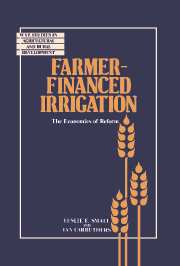Book contents
- Frontmatter
- Contents
- Preface
- 1 Irrigation financing in perspective
- Part I Analysing financing policies: theory and concepts
- Part II Criteria for evaluating irrigation financing policies
- 4 Cost-effective operation and maintenance
- 5 Allocating a scarce resource: water-use efficiency
- 6 Improving investment decisions
- 7 Resource-mobilisation efficiency
- 8 The concern for equity
- Part III Financial autonomy and user fees: key implementation issues
- Notes
- Index
5 - Allocating a scarce resource: water-use efficiency
Published online by Cambridge University Press: 05 November 2011
- Frontmatter
- Contents
- Preface
- 1 Irrigation financing in perspective
- Part I Analysing financing policies: theory and concepts
- Part II Criteria for evaluating irrigation financing policies
- 4 Cost-effective operation and maintenance
- 5 Allocating a scarce resource: water-use efficiency
- 6 Improving investment decisions
- 7 Resource-mobilisation efficiency
- 8 The concern for equity
- Part III Financial autonomy and user fees: key implementation issues
- Notes
- Index
Summary
How often one hears the complaint that irrigation water is wasted! Farmers who are favourably located along the irrigation canals tend to use more water than ‘needed’, frequently increasing the problems of shortages and unreliable supplies for the tail-end farmers. The resulting ‘inefficient’ allocation and use of water seems obvious to many irrigation professionals. Engineers note that technical water-use efficiency (the ratio of the amount of water actually used by the plants to the amount of water entering the irrigation system) is very low. Irrigation agronomists focus on the large differences between the amounts of water applied to farmers' fields and the amounts needed by the crops for optimal crop growth.
Economists, however, have a different (and in some ways more difficult) approach to evaluating inefficiency in irrigation. They evaluate efficiency in the allocation and use of water from the broader perspective of economic efficiency. Water must therefore be considered, not as an isolated and separable input used in agricultural production, but as one of many interrelated inputs whose use must be optimally integrated in a flexible production ‘package’. Prices (be they market prices or shadow prices) become the common denominator by which the various components of this production package can be compared, and through which efficiency can be evaluated.
Many economists, noting both the ‘waste’ of irrigation water and the frequency of large subsidies given in ways that make the use of this water free at the margin, have concluded that much of the waste is due to inappropriate water prices.
- Type
- Chapter
- Information
- Farmer-Financed IrrigationThe Economics of Reform, pp. 77 - 95Publisher: Cambridge University PressPrint publication year: 1991

